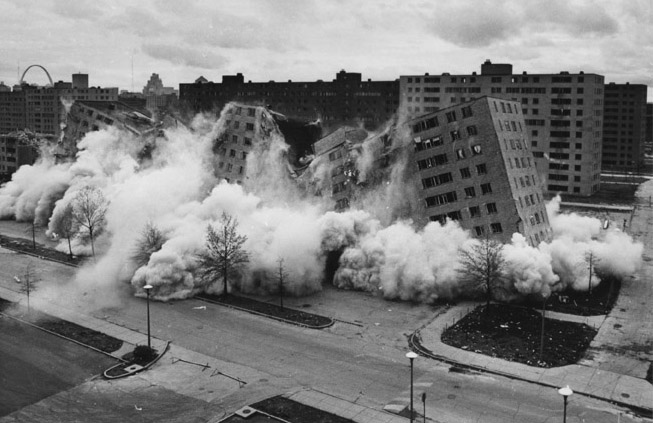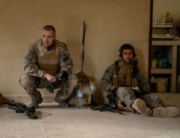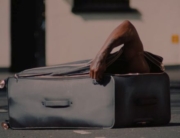
The Pruitt-Igoe Myth: An Urban History begins with a shocking image. Not the dramatic, notorious television footage of the 1972 implosion of an 11-story building in the St. Louis Pruitt-Igoe public housing project. It’s a tour of what’s on the 55 acres now, since all 33 buildings in the complex were torn down: nothing, just some tall weeds and garbage. Chad Freidrichs’s documentary does more than trace the ups and downs of those infamous buildings. It looks into the people, politics, and policies behind their construction and demolition as symbols of a national debate.
Across the U.S., public housing came out of the post-World War II confluence of lobbyists for federal funding for slum clearance: progressives concerned about the lack of quality, affordable housing for the anticipated urban population increase due to the baby boom and the migration of rural southerners to cities; and downtown business and construction interests. Initially planned as separate, segregated projects named for two local heroes, Tuskegee Airman Wendell Pruitt and white Congressman William Igoe, it was designed on the grand scale of Le Corbusier’s 1920s model for his “Contemporary City” of tall towers set in green plazas, as interpreted by Minoru Yamasaki, later the architect of the comparably modernist World Trade Center.
Freidrichs interviews early residents who recall their excitement and pleasure at moving in 1956 from sub-standard housing to the new buildings, poignantly interwoven with a promotional film from the St. Louis Public Housing Authority (among the terrific and striking archival footage). One woman describes going from a three-room shack for 12 people to where “Everybody had a bed!” Another woman describes her view from “the poor man’s penthouse.” They talk warmly of Christmas parties, mothers cooking, watching out for playing children, and lifelong friendships.
So what went wrong? In exploding “myths,” Freidrichs explores several more factors, some specific to St. Louis and some typical of other cities. While the residents remember that there was a small, overwhelmed maintenance staff, federal funds were only for the initial construction. Funding for the upkeep was supposed to come out of rents. As jobs in the city for the working poor disappeared, one way the authority tried to guarantee a rent flow was through social engineering, giving priority to single mothers eligible for government welfare. Several former residents describe learning to lie at a young age, hiding the man of the house from the overweening social workers in order to qualify.
Historian Robert Fishman notes that additional forces were at work to empty the vandalized buildings. The expected urban population increase didn’t happen, and rapid suburbanization did, specifically white flight. The film cites glaring statistics, such as the city losing 60% of its population over the decades, and unearths vivid TV coverage of the white residents of Black Jack, Missouri, speaking out against “trash people” moving into their town. However, the impact of restricted federal mortgage subsidies to suburbs redlined against minorities is not cited. (Glaringly not included are excerpts of the anti-slum campaigners behind Willard Van Dyke and Pare Lorentz’s award-winning promotional film for the 1939 World’s Fair, The City. They envisioned the “World of Tomorrow” as suburban.) The interviewees colorfully remember their survival strategies in scary, broken elevators and against bullies as the drug trade moved in. Crime dominated the menacing headlines about this project, and public housing in general, whether appropriate or not.
I saw the project myself in 1973, a year before the site was razed. My husband and I had started dating in a college city planning course, and our first stop on a cross-country trip was to Pruitt-Igoe, whose design ills we had studied. Not that the tourist office was too keen on showing us where it was. We were more struck how isolated the complex was, boxed in by federally funded highways that blocked access to jobs, shopping, institutions, and services. And we saw a historic, depopulated city full of failed urban renewal efforts, not just Pruitt-Igoe. While I can quibble about the facts Freidrichs chooses to emphasize or omit, the memorable images and valuable personal testimonies—and that long walk through the huge, shamefully empty lot—should help frame a discussion that this country didn’t then, and still doesn’t, have an effective urban housing policy.
















Leave A Comment